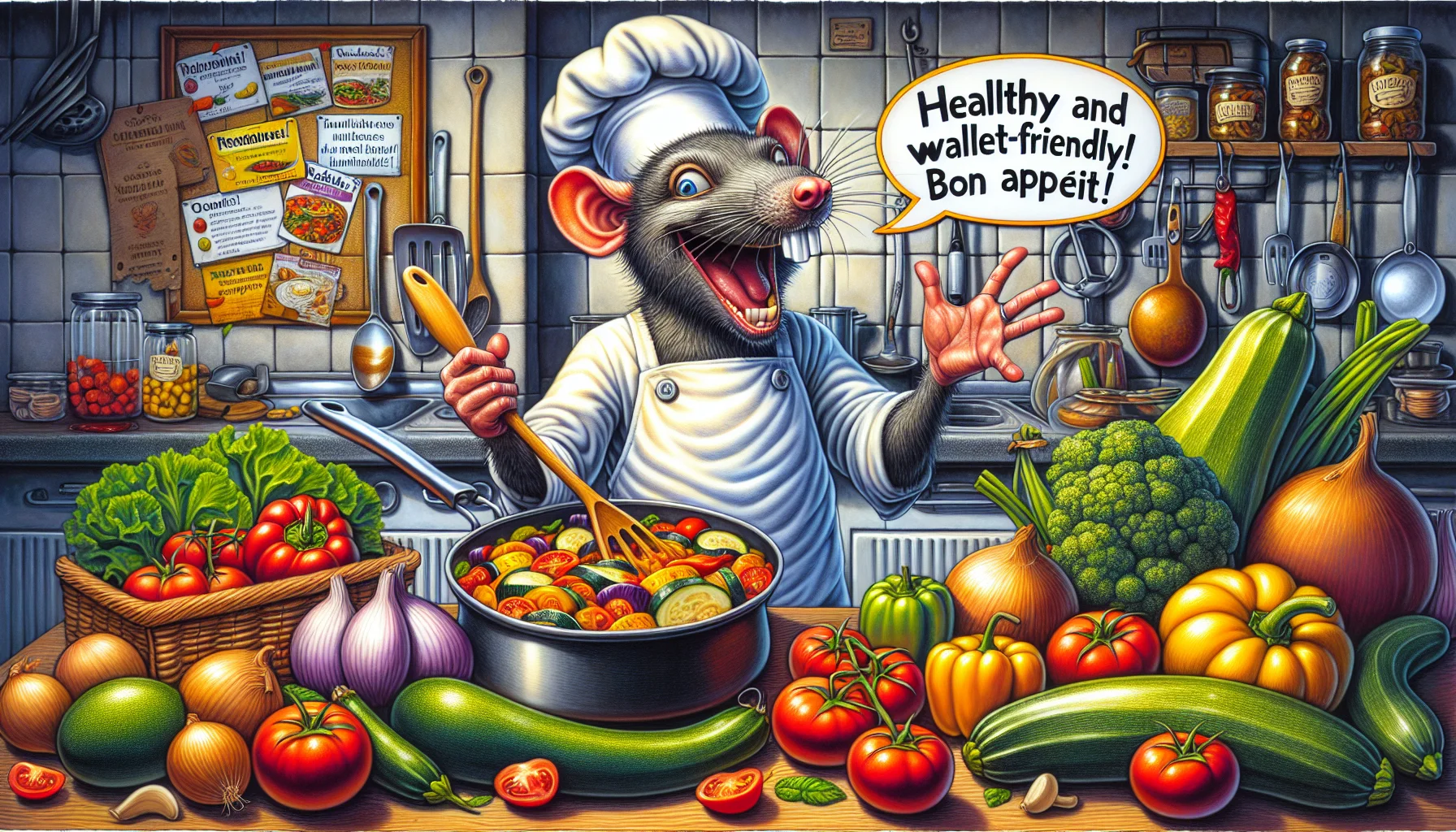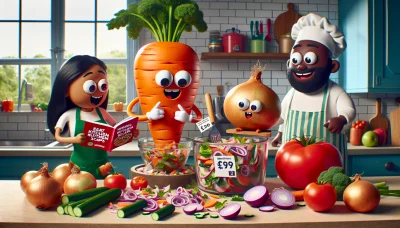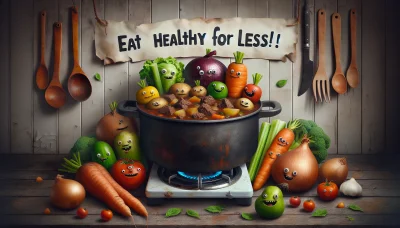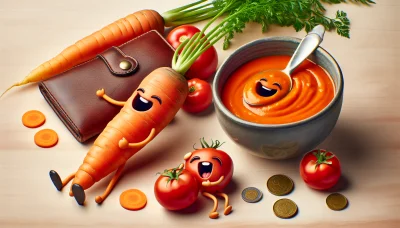French ratatouille recipe Quiz
Test Your Knowledge
Question of
French Ratatouille Recipe: A Healthy Delight
Ratatouille is a traditional French dish that hails from the region of Provence. This stewed vegetable dish is not only a celebration of late summer vegetables, such as tomatoes, zucchini, eggplant, and bell peppers, but it also embodies the essence of Provencal cooking. Ratatouille's origins can be traced back to the 18th century, where it started as a humble meal for farmers using the vegetables they had on hand. Over time, it has evolved into a beloved classic of French cuisine, enjoyed by food lovers worldwide. In addition to its rich cultural heritage, ratatouille is renowned for its health benefits. Packed with a variety of vegetables, it is high in dietary fiber, vitamins, and antioxidants while being low in calories, making it an excellent choice for anyone looking to maintain a healthy diet.
Ingredients for a Classic Ratatouille
- 1 eggplant
- 2 zucchinis
- 2 yellow squash
- 1 bell pepper (preferably red)
- 2 to 3 tomatoes
- 1 onion
- 2 cloves of garlic
- Olive oil
- Fresh thyme
- Salt and pepper to taste
Step-by-Step Cooking Instructions
Follow these simple steps to prepare a healthy and delicious ratatouille, a classic vegetable dish that's both nutritious and flavorful.
- Start by gathering fresh ingredients: tomatoes, zucchini, eggplant, bell peppers, onion, and garlic.
- Wash all the vegetables thoroughly under cold water to ensure they are clean.
- Cut the eggplant and zucchini into round slices, and chop the bell peppers, onion, and tomatoes into bite-sized pieces.
- In a large pan, heat a tablespoon of olive oil over medium heat. Add the chopped onions and minced garlic, sautéing until they are soft and fragrant.
- Add the chopped tomatoes to the pan, cooking them down into a sauce. Season with salt, pepper, and a pinch of herbs de Provence for that authentic French flavor.
- Once the sauce is simmering, layer the sliced vegetables (eggplant, zucchini, and bell peppers) over the sauce. The arrangement doesn't have to be perfect, but a little effort adds to the presentation.
- Cover the pan and let it simmer on low heat for about 40 minutes. This slow cooking process allows the flavors to meld together beautifully without losing the individual textures of the vegetables.
- Check the ratatouille occasionally, gently stirring to prevent sticking, and ensuring even cooking.
- Once the vegetables are tender and the sauce is rich and flavorful, remove the pan from heat. Let it cool for a few minutes before serving.
- Garnish with fresh basil or parsley for an added touch of color and freshness.
This ratatouille is not only a testament to the simplicity of cooking with vegetables but also highlights how a few basic ingredients can transform into a hearty, healthy meal. Enjoy it as a main dish or as a complement to your favorite protein.
Nutritional Benefits of Ratatouille
Ratatouille is a traditional French stewed vegetable dish that is not only bursting with flavor but also packed with nutritional benefits. One of the most appealing aspects of ratatouille is its low-calorie content. This makes it an excellent dish for those looking to maintain a healthy weight or reduce their calorie intake without sacrificing taste or satisfaction.
Another significant benefit of ratatouille is its high fiber content. The vegetables used in ratatouille, such as eggplant, zucchini, tomatoes, and bell peppers, are all excellent sources of dietary fiber. Fiber is crucial for maintaining a healthy digestive system, helping to prevent constipation, and may contribute to lowering cholesterol levels. Additionally, a diet high in fiber can help you feel full longer, which can aid in weight management.
Beyond its low calories and high fiber, ratatouille is rich in vitamins and minerals. The variety of vegetables included in the dish provides a wide range of nutrients, including vitamin C, potassium, vitamin A, and several antioxidants. These nutrients are vital for supporting the immune system, promoting healthy skin and vision, and reducing the risk of chronic diseases. The antioxidants found in ratatouille can help protect the body from damage by free radicals, contributing to overall health and longevity.
Incorporating ratatouille into your diet can be a delicious way to enjoy a balanced diet that supports health and wellness. Its combination of low calories, high fiber, and rich vitamin and mineral content makes ratatouille a nutritious choice for anyone looking to eat healthily and deliciously.
Serving Suggestions for Ratatouille
Ratatouille, a classic French vegetable stew, is as versatile as it is delicious. For a hearty and healthy meal, consider serving it atop a bed of whole grain quinoa or brown rice, which complements the stew's rich flavors while adding a nutritious boost. For those looking for a low-carb option, ratatouille pairs beautifully with grilled chicken or fish, offering a balanced meal that is both satisfying and light. To enhance the Mediterranean vibes, consider adding a side of crusty whole-grain bread to soak up the delightful juices, turning your ratatouille into a feast for the senses. Whether you're enjoying it as a main dish or a side, ratatouille brings a touch of Provencal sunshine to any table.
Tips for the Perfect Ratatouille
- Use fresh, high-quality vegetables. The fresher your ingredients, the more flavorful your ratatouille will be.
- Roast your vegetables before adding them to the dish. This enhances their natural flavors and adds a delightful texture.
- Incorporate a variety of herbs such as thyme, rosemary, and basil for a rich, aromatic flavor profile.
- Opt for olive oil instead of butter for a healthier fat option that doesn't compromise on taste.
- Let the ratatouille simmer on low heat for an extended period. This allows the flavors to meld together beautifully.
- Add a splash of balsamic vinegar or a squeeze of fresh lemon juice before serving to brighten the dish with a subtle acidity.
- Consider adding a pinch of smoked paprika for a slight smoky flavor that complements the vegetables well.
- Don't rush the cooking process. Patience is key to allowing each ingredient to cook to perfection.
- Experiment with different vegetable combinations to find the mix that best suits your taste preferences.
- Serve with a side of whole grain bread to soak up the delicious juices without compromising on health.
Frequently Asked Questions
| Question | Answer |
|---|---|
| Can I substitute zucchini with another vegetable? | Yes, you can use yellow squash as a close substitute for zucchini to maintain a similar texture and nutritional profile. |
| What is the best way to store leftover ratatouille? | Store it in an airtight container in the refrigerator for up to 5 days. You can also freeze it for up to 3 months. |
| Can I use canned tomatoes instead of fresh ones? | Yes, canned tomatoes can be a convenient substitute. Opt for no-salt-added varieties to keep the dish healthy. |
| Is there a low-fat alternative to olive oil in the recipe? | While olive oil is a healthy fat, you can reduce the amount or use a spray to coat your pan for a lower-fat version. |
| How can I enhance the flavor without adding salt? | Increase the herbs like basil, thyme, and oregano, and consider a splash of balsamic vinegar for depth without added sodium. |
| What are some healthy serving suggestions? | Serve over whole grain pasta, brown rice, or alongside grilled chicken or fish to keep the meal balanced and nutritious. |












